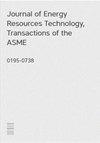油基和水基钻井液输送岩屑
IF 2.4
3区 工程技术
Q3 ENERGY & FUELS
Journal of Energy Resources Technology-transactions of The Asme
Pub Date : 2023-10-18
DOI:10.1115/1.4063838
引用次数: 0
摘要
摘要斜井段是现代海上油井施工设计中常见的问题。在北海地区,这是成熟地区的一个很好的例子,几乎所有的生产井或注入井都有大斜度井段。这些井必须在功能、钻井时间、风险和所有相关成本方面以最佳方式建造。多年来,大多数井眼清洗和水力模型都是基于模型流体的相对小规模实验室测试的实验结果而开发的。用于现场应用的实际钻井液的井眼清洁特性和水力特性与大多数模型流体不同。此外,由于存在大量的尺寸量,如速度、流体性质、时间、长度和其他尺度差异,小直径测试的结果可能并不总是与现场应用相关,也无法扩展到现场应用。因此,有必要在受控的实验室环境中使用足够的大型实验设施,并应用各种现场设计的钻井液进行研究,以改进工程模型和操作实践。本文介绍了使用现场应用钻井液进行此类实验室测试的结果。在对比试验中,不同钻井液在相应的现场应用剪切速率范围内具有相似的密度和粘度函数。该剪切速率范围也在试验中进行了评估。一种是油基钻井液,另一种是KCl/聚合物型的抑制性水基钻井液。本文章由计算机程序翻译,如有差异,请以英文原文为准。
Cuttings Transport With Oil- and Water-Based Drilling Fluids
Abstract Deviated well sections are common in most modern offshore well construction designs. In the North Sea region, which is a good example of mature areas, practically all producer or injector wells have highly deviated well sections. These wells must be constructed in an optimal manner with respect to functionality, drill time, risk and all affiliated costs. Throughout the years, most hole cleaning and hydraulic models are developed based on experimental results from relatively small scale laboratory tests with model fluids. Hole cleaning properties and hydraulic behaviour of practical drilling fluids intended for field application differ from those of most model fluids. Furthermore, results from small diameter tests may not always be relevant for, nor scalable to field applications because of presence of a huge number of dimensional quantities like velocity, fluid properties, time, length and other scale differences. Hence, studies using sufficient large scale experimental facilities in controlled laboratory environments with the application of various field designed drilling fluids are necessary to improve engineering models and operational practices. The current paper presents results from such laboratory tests where field applied drilling fluids have been used. In comparison tests the different drilling fluids have similar density and viscosity functions within the relevant field applied shear rate range. This shear rate range is also assessed in the tests. One of the drilling fluids is oil-based and the other one is an inhibitive water-based drilling fluid of the KCl/polymer type.
求助全文
通过发布文献求助,成功后即可免费获取论文全文。
去求助
来源期刊
CiteScore
6.40
自引率
30.00%
发文量
213
审稿时长
4.5 months
期刊介绍:
Specific areas of importance including, but not limited to: Fundamentals of thermodynamics such as energy, entropy and exergy, laws of thermodynamics; Thermoeconomics; Alternative and renewable energy sources; Internal combustion engines; (Geo) thermal energy storage and conversion systems; Fundamental combustion of fuels; Energy resource recovery from biomass and solid wastes; Carbon capture; Land and offshore wells drilling; Production and reservoir engineering;, Economics of energy resource exploitation

 求助内容:
求助内容: 应助结果提醒方式:
应助结果提醒方式:


